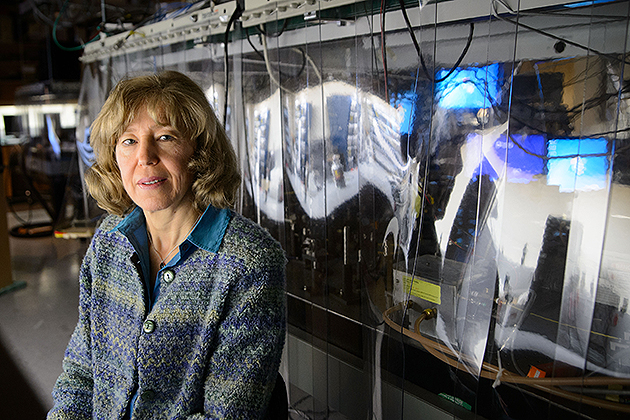
The Department of Physics in the College of Liberal Arts and Sciences welcomed its new head, Professor Nora Berrah, to Storrs this week. Berrah brings to UConn an international reputation as an accomplished atomic, molecular, and optical physicist, along with a passion for showing students of all ages, especially women and minorities, that physics is an accessible and exciting field.
“It’s a myth that physics is hard. It’s a welcoming field that is fun and exciting,” says Berrah, who joins UConn from Western Michigan University, where she was a Distinguished University Professor. “It’s like opening up a door to a world you never knew existed. What could be better than understanding what’s around you and how things work?”
Physics for the people
From a young age, Berrah, who grew up in Algeria and attended the Université d’Alger, says she had a keen curiosity for the sciences. In her school system, students were exposed to specific disciplines like physics as early as middle school.
Because of this early exposure, and because of the early 20th-century physicist Marie Curie’s influence as a Nobel Prize winner, Berrah says that French-speaking countries have one of the highest percentages of women in physics in the world. Matching these outcomes in the U.S. is one of Berrah’s lifelong goals.
A 2013 report by the American Institute of Physics revealed that in the U.S., 14 percent of college and university tenure- and non-tenure-track faculty positions in physics are held by women, and only eight percent of senior, or “full,” professors are women.
As chair of the national American Physical Society (APS) Committee on the Status of Women in Physics in 2007-08, Berrah led a workshop that convened more than 50 heads of physics departments from U.S. universities and national laboratories to produce a report and recommendations to increase the number of women in physics.
The workshop concluded that women need to be recruited into physics early in life, retained in the field through mentorship and other encouragement, and rewarded with promotions at the same rate as men.
The crucial first step, Berrah says, is exposing girls to STEM fields from a young age. Berrah herself has spoken in U.S. high schools and mentored women across the world, in Sweden, Morocco, Algeria, Tunisia, and the U.S.
“How are you going to know if you like physics if you’ve never been exposed to it?” she says.
Beyond Star Wars
Berrah’s own research in atomic, molecular, and optical physics concerns the interactions of matter with light. Using lasers – like the Linac Coherent Light Source (LCLS) at Stanford University, the most powerful x-ray laser in the world – Berrah’s research explores what happens deep inside molecules and nanosystems when exposed to ultra-intense beams of light.
For example, in some of her research, Berrah and her colleagues study thymine, a component of DNA that helps to protect skin from sunburn. Using ultrafast laser light to probe how thymine absorbs ultraviolet radiation can help scientists understand the time scale of its natural sunscreen-like properties.
A Fellow of the APS, she received the Society’s 2014 Davisson-Germer Prize in Atomic or Surface Physics “for pioneering experiments on the interaction of atoms, molecules, negative ions, and clusters with ionizing vacuum ultraviolet and soft x-ray photons.”
College of Liberal Arts and Sciences dean Jeremy Teitelbaum is especially proud to have Berrah at UConn.
“Nora is a national expert in laser physics and has been an effective advocate for women in physics and in science more broadly,” says Teitelbaum. “I look forward to working with her to build a stronger and more diverse physics department at UConn.”
Physics for success
As a teacher, Berrah impresses upon her students that physics is a gateway to an exciting, fulfilling, and successful career. People who study physics can work not only in various industries and in education, but even in health care and financial and business fields such as investment banking.
For her own part, Berrah came to UConn because she was inspired by a state that had invested so many resources in higher education, in initiatives such as Next Generation Connecticut.
“I wanted to be part of the University in a state that values education and excellence in advancing the STEM fields and that is funding the University at the level it promised,” she says. “They don’t just pay lip service to education. They really believe in it, since they are doing it. It’s exciting to be part of this enterprise.”
As department head, she hopes to continue to grow UConn’s physics program.
“We want to continue to recruit excellent students and hire excellent faculty who do excellent science,” she says.
Berrah plans to collaborate with the group of atomic and molecular physicists at UConn, and also with researchers in chemistry, engineering, and biology. But she acknowledges that no matter how much work scientists do, it will never be enough to understand the many puzzles nature has in store.
“The more I know about physics, the more I realize that a lifetime isn’t enough to know all there is to know about it,” Berrah says.
Read a summary of Berrah’s January 2014 article in Scientific American, ‘The Ultimate X-Ray Machine’ here. A subscription is required to read the full article, however readers in the UConn domain can access the journal article here.


